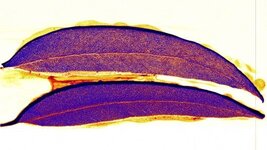Sheldon J
Hero Member
From "Gold leaf" trees discovered in the Australian outback


Scientists from Australia's Commonwealth Scientific and Industrial Research Organisation (CSIRO) have discovered that eucalyptus trees in the Australian outback are drawing up gold particles from deep underground through their root system and depositing the precious metal in their leaves and branches. Rather than being a new source of "gold leaf," the discovery could provide a cheaper, more environmentally friendly way to uncover valuable gold ore deposits.
Using the science organization's Maia detector for x-ray elemental imaging at the Australian Synchrotron, the researchers were able to produce images that clearly showed deposits of gold and other metals in the structure of Eucalyptus leaves from the Kalgoorlie region of Western Australia that would have been untraceable using other methods.
"The eucalypt acts as a hydraulic pump – its roots extend tens of meters into the ground and draw up water containing the gold. As the gold is likely to be toxic to the plant, it’s moved to the leaves and branches where it can be released or shed to the ground," says CSIRO geochemist Dr Mel Lintern.
Because the leaf-bound "nuggets" are only about one-fifth the diameter of a human hair, prospectors aren't going to turn a profit by collecting leaf litter. Dr Lintern told ABC News that it would take the gold from 500 big eucalyptus trees growing directly over a gold deposit to produce a gold wedding ring. However, because eucalypt trees are so common across Australia, the discovery could provide mining companies with a cheaper and less environmentally damaging exploration approach than drilling.
"By sampling and analyzing vegetation for traces of minerals, we may get an idea of what’s happening below the surface without the need to drill," says Dr Lintern. "It’s a more targeted way of searching for minerals that reduces costs and impact on the environment."
The x-ray imaging technique also revealed the presence of other metals in the leaves, which opens up the potential for the technique to be used to detect deposits of metals such as zinc and copper, the researchers say.
The CSIRO team has published details of their discovery in the journal Nature Communications.
Source: CSIRO




